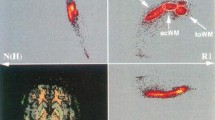Abstract
Objective A method for segmenting the temporalis from magnetic resonance (MR) images was developed and tested. The temporalis muscle is one of the muscles of mastication which plays a major role in the mastication system.
Materials and methods The temporalis region of interest (ROI) and the head ROI are defined in reference images, from which the spatial relationship between the two ROIs is derived. This relationship is used to define the temporalis ROI in a study image. Range-constrained thresholding is then employed to remove the fat, bone marrow and muscle tendon in the ROI. Adaptive morphological operations are then applied to first remove the brain tissue, followed by the removal of the other soft tissues surrounding the temporalis. Ten adult head MR data sets were processed to test this method.
Results Using five data sets each for training and testing, the method was applied to the segmentation of the temporalis in 25 MR images (five from each test set). An average overlap index (κ) of 90.2% was obtained. Applying a leave-one-out evaluation method, an average κ of 90.5% was obtained from 50 test images.
Conclusion A method for segmenting the temporalis from MR images was developed and tested on in vivo data sets. The results show that there is consistency between manual and automatic segmentations.
Similar content being viewed by others
References
Meehan M, Teschner M, Girod S (2003) Three-dimensional simulation and prediction of craniofacial surgery. J Orthodon Craniofac Res 6(1):103–107
Xia J, Samman N, Yeung RW, Wang D, Shen SG, Ip HH, Tideman H (2000) Computer-assisted three-dimensional surgical planning and simulation. 3D soft tissue planning and prediction. Int J Oral Maxillofac Surg 29(4):250–258
Gladilin E, Zachow S, Deuflhard P, Hege HC (2004) Anatomy and physics-based facial animation for craniofacial surgery simulations. Med Biol Eng Comput 42(2):167–170
Ng HP, Ong SH, Hu QM, Foong KWC, Goh PS, Nowinski WL (2006) Muscles of mastication model-based MR image segmentation. Int J Comput Assis Radiol Surg 1(3):137–148
Hu QM, Hou ZJ, Nowinski WL (2006) Supervised range- constrained thresholding. IEEE Trans Image Process 15(1):228–240
Qiao Y, Hu QM, Qian GY, Luo SH, Nowinski WL (2007) Thresholding based on variance and intensity contrast. Patt Recogn 40(2):596–608
Vasilic B, Wehrli FW (2005) A novel local thresholding algorithm for trabecular bone volume fraction mapping in the limited spatial resolution regime of in vivo MRI. IEEE Trans Med Imaging 24(12):1574–1585
Shiffman S, Rubin GD, Napel S (2000) Medical image segmentation using analysis of isolable-contour maps. IEEE Trans Med Imaging 19(11):1064–1074
Ray N, Acton ST, Altes T, Lange EE, Brookeman JR (2003) Merging parametric active contours within homogeneous image regions for MRI-based lung segmentation. IEEE Trans Med Imaging 22(2):189–199
Pluempitiwiriyawej C, Moura JMF, Wu YJ, Ho C (2005) STACS: New active contour scheme for cardiac MR image segmentation. IEEE Trans Med Imaging 24(5):593–603
Xu C, Prince JL (1998) Snakes, shapes, and gradient vector flow. IEEE Trans Image Process 7(3):359–369
Shen S, Sandham W, Granat M, Sterr A (2005) MRI fuzzy segmentation of brain tissue using neighborhood attraction with neural-network optimization. IEEE Trans Inform Technol Biomed 9(3):459–467
Otsu N (1979) A threshold selection method from gray-level histograms. IEEE Trans Syst Man Cybern 9(1):62–66
Hu QM, Qian GY, Nowinski WL (2005) Fast connected-component labelling in three-dimensional binary images based on iterative recursion. Comput Visi Image Understand 99(3):414–434
Leemput VK, Maes F, Vandermeulen D, Suetens P (1999) Automated model-based tissue classification of MR images of the brain. IEEE Trans on Med Imag 18(10):897–908
Fukunaga K, Hummels DM (1989) Leave-one-out procedures for nonparametric error estimates. IEEE Trans Patt Anal Mach Intell 11(4):421–423
Hu QM, Nowinski WL (2003) A rapid algorithm for robust and automatic extraction of the midsagittal plane of the human cerebrum from neuroimages based on local symmetry and outlier removal. NeuroImage 20(4):2153–2165
Hou ZJ, Hu QM, Nowinski WL (2006) On minimum variance thresholding. Patt Recogn Lett 27(14):1732–1743
Suri JS, Liu K, Singh S, Laxminarayan SN, Zeng X, Reden L (2002) Shape recovery algorithms using level sets in 2-D/3-D medical imagery: a state-of-the-art review. IEEE Trans Inform Technol Biomed 6(1):8–28
Yang J, Staib LH, Duncan JS (2004) Neighbor-constrained segmentation with level set based 3-D deformable models. IEEE Trans Med Imaging 23(8):940–948
Author information
Authors and Affiliations
Corresponding author
Rights and permissions
About this article
Cite this article
Ng, H.P., Hu, Q.M., Ong, S.H. et al. Segmentation of the temporalis muscle from MR data. Int J CARS 2, 19–30 (2007). https://doi.org/10.1007/s11548-007-0073-9
Received:
Accepted:
Published:
Issue Date:
DOI: https://doi.org/10.1007/s11548-007-0073-9




